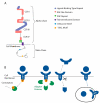Plasma Membrane Receptors Involved in the Binding and Response of Osteoclasts to Noncellular Components of the Bone
- PMID: 34576260
- PMCID: PMC8466431
- DOI: 10.3390/ijms221810097
Plasma Membrane Receptors Involved in the Binding and Response of Osteoclasts to Noncellular Components of the Bone
Abstract
Osteoclasts differentiate from hematopoietic cells and resorb the bone in response to various signals, some of which are received directly from noncellular elements of the bone. In vitro, adherence to the bone triggers the reduction of cell-cell fusion events between osteoclasts and the activation of osteoclasts to form unusual dynamic cytoskeletal and membrane structures that are required for degrading the bone. Integrins on the surface of osteoclasts are known to receive regulatory signals from the bone matrix. Regulation of the availability of these signals is accomplished by enzymatic alterations of the bone matrix by protease activity and phosphorylation/dephosphorylation events. Other membrane receptors are present in osteoclasts and may interact with as yet unidentified signals in the bone. Bone mineral has been shown to have regulatory effects on osteoclasts, and osteoclast activity is also directly modulated by mechanical stress. As understanding of how osteoclasts and other bone cells interact with the bone has emerged, increasingly sophisticated efforts have been made to create bone biomimetics that reproduce both the structural properties of the bone and the bone's ability to regulate osteoclasts and other bone cells. A more complete understanding of the interactions between osteoclasts and the bone may lead to new strategies for the treatment of bone diseases and the production of bone biomimetics to repair defects.
Keywords: CD44; LRP1; V-ATPase; bone remodeling; extracellular vesicles; integrins; osteopontin; synaptotagmin; vacuolar H+-ATPase.
Conflict of interest statement
The authors declare no conflict of interest.
Figures






Similar articles
-
Linarin and its aglycone acacetin abrogate actin ring formation and focal contact to bone matrix of bone-resorbing osteoclasts through inhibition of αvβ3 integrin and core-linked CD44.Phytomedicine. 2020 Dec;79:153351. doi: 10.1016/j.phymed.2020.153351. Epub 2020 Sep 20. Phytomedicine. 2020. PMID: 32987362
-
Specialized Roles for Actin in Osteoclasts: Unanswered Questions and Therapeutic Opportunities.Biomolecules. 2019 Jan 9;9(1):17. doi: 10.3390/biom9010017. Biomolecules. 2019. PMID: 30634501 Free PMC article. Review.
-
Role of cell-matrix interactions in osteoclast differentiation.Adv Exp Med Biol. 2007;602:107-11. doi: 10.1007/978-0-387-72009-8_14. Adv Exp Med Biol. 2007. PMID: 17966395
-
Integrin-mediated signaling in the regulation of osteoclast adhesion and activation.Front Biosci. 1998 Aug 1;3:d757-68. doi: 10.2741/A319. Front Biosci. 1998. PMID: 9682033 Review.
-
Interactions between the bone matrix proteins osteopontin and bone sialoprotein and the osteoclast integrin alpha v beta 3 potentiate bone resorption.J Biol Chem. 1993 May 5;268(13):9901-7. J Biol Chem. 1993. PMID: 8486670
Cited by
-
Multimodal regulation of the osteoclastogenesis process by secreted group IIA phospholipase A2.Front Cell Dev Biol. 2022 Aug 29;10:966950. doi: 10.3389/fcell.2022.966950. eCollection 2022. Front Cell Dev Biol. 2022. PMID: 36105351 Free PMC article.
-
Metabolomic signatures distinguish extracellular vesicles from osteoclasts and odontoclasts.Orthod Craniofac Res. 2023 Nov;26(4):632-641. doi: 10.1111/ocr.12658. Epub 2023 Apr 5. Orthod Craniofac Res. 2023. PMID: 36997279 Free PMC article.
References
Publication types
MeSH terms
Substances
LinkOut - more resources
Full Text Sources
Research Materials
Miscellaneous

